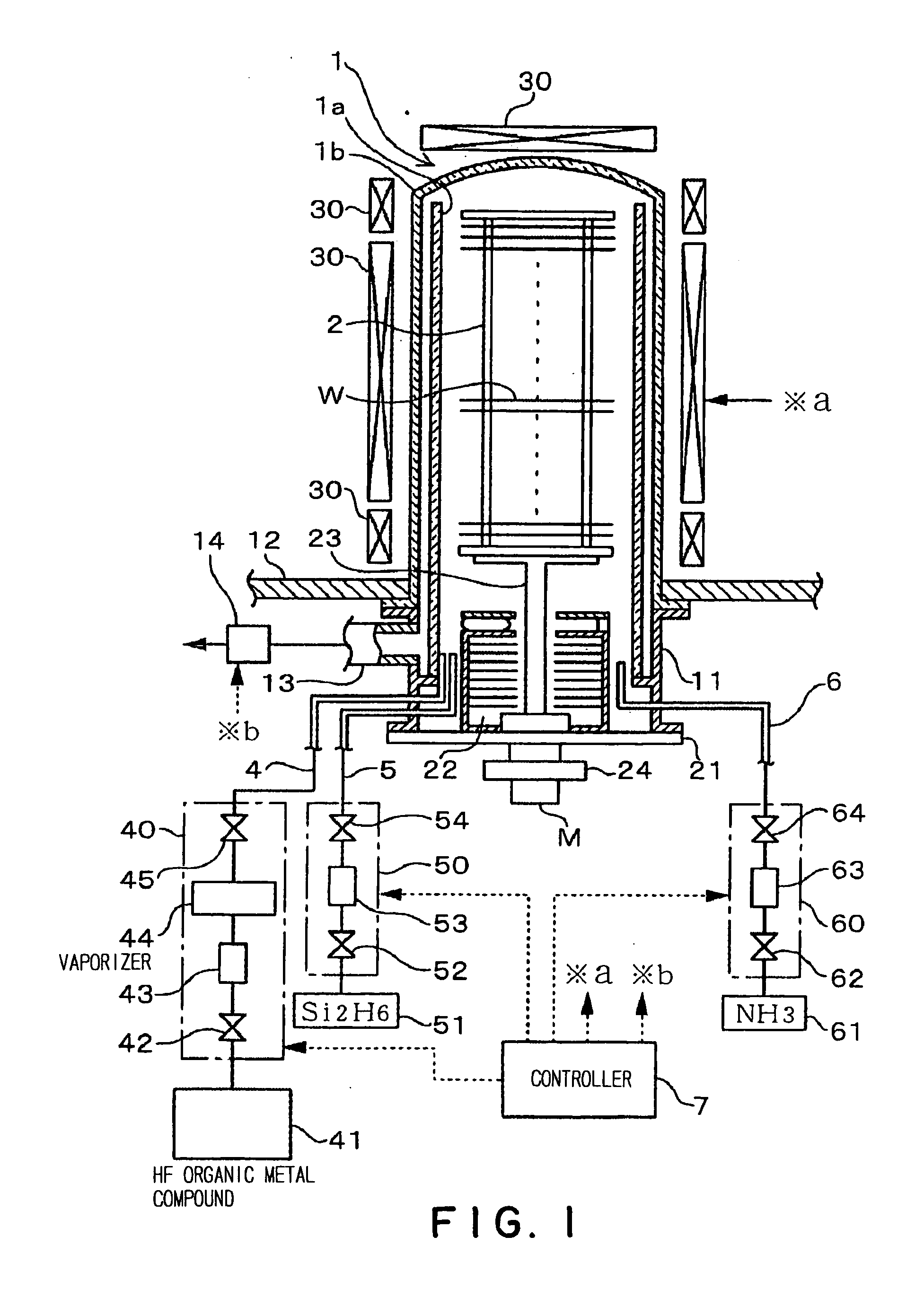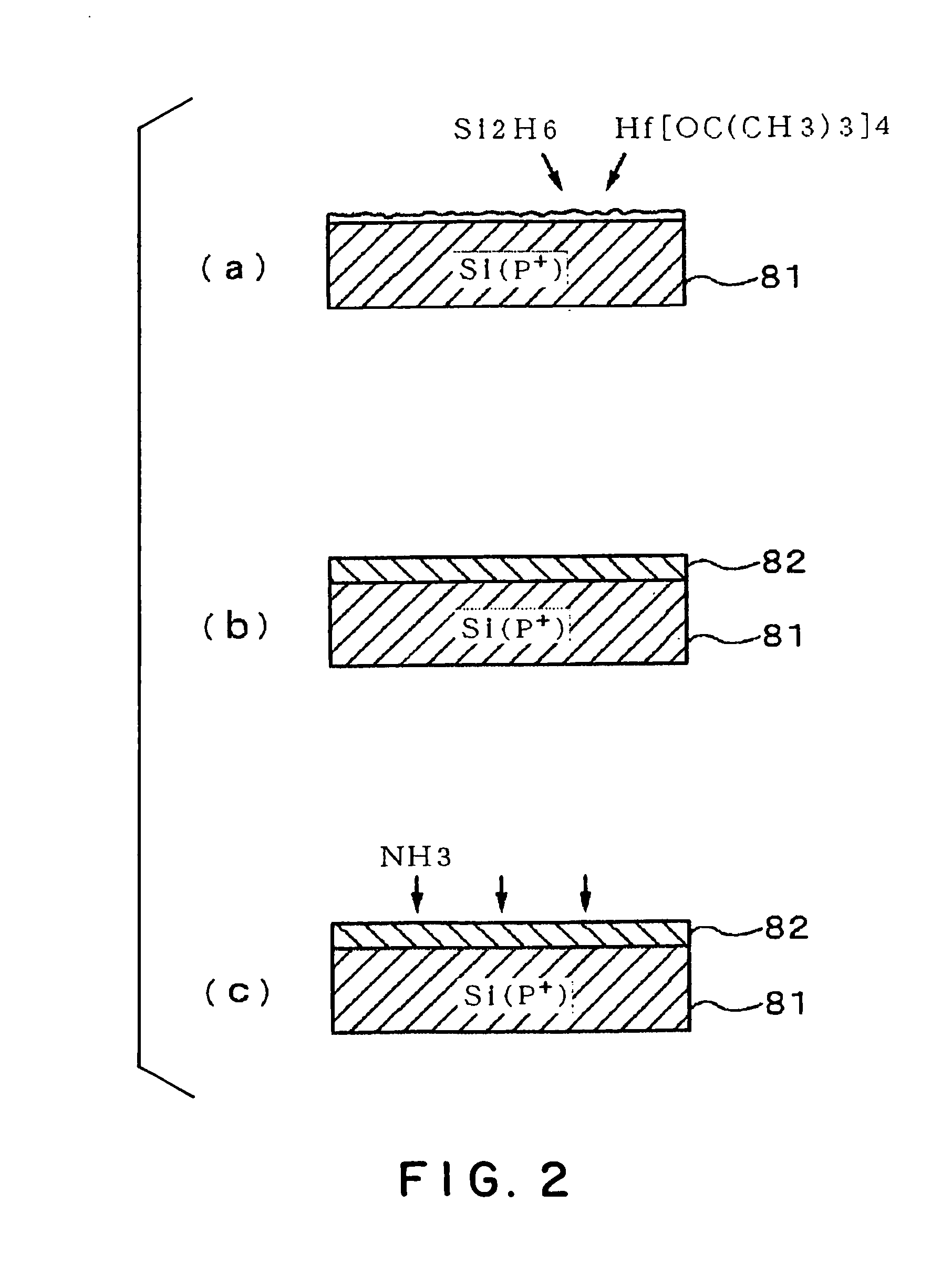Method of forming film and film forming apparatus
a film and film forming technology, applied in the direction of coatings, transistors, chemical vapor deposition coatings, etc., can solve the problems of gate oxide film disadvantageous increase, uncontrollable increase of leakage current, grain boundary leakage current, etc., to achieve suppressed leakage current, high crystallization temperature, and easy removal of silicon conten
- Summary
- Abstract
- Description
- Claims
- Application Information
AI Technical Summary
Benefits of technology
Problems solved by technology
Method used
Image
Examples
example 1
[0052] By using the vertical heat treatment apparatus shown in FIG. 1, hafnium silicate film having a thickness of about 15 nm were deposited on silicon substrates, each having a P-type silicon film previously deposited on a surface thereof. Film-deposition conditions were as follows:
Temperature in the reaction tube: 250° C.
Pressure in the reaction tube: 40 Pa
Flow rate of tetra-tertiary-butoxy hafnium: 0.25 sccm (liquid flow rate)
Flow rate of disilane gas: 1,000 sccm
[0053] In order to examine the crystallization temperature of the hafnium silicate film deposited under the above conditions, the substrates were heated for one minute in an inert gas atmosphere, at different temperatures of 800° C., 850° C., 900° C. and 950° C., respectively. Then, x-ray diffraction analysis was conducted with respect to each of the heated hafnium silicate films. FIG. 4 shows the results. As is apparent from FIG. 4, in the substrate heated at 900° C., a (111) hafnium oxide peak appears at a pos...
example 2
[0054] By using monosilane gas in place of disilane gas, hafnium silicate film having a thickness of about 15 nm were deposited on silicon substrates, each having a P-type silicon film previously deposited on a surface thereof. The flow rate of monosilane gas was 1,000 sccm, which is similar to that of the disilane gas in the Example 1. Other film-deposition conditions were the same as those in Example 1.
[0055] The thus obtained substrates were heated under the same conditions as those in Example 1, and then x-ray diffraction analysis were conducted. FIG. 5 shows the results. As is apparent from FIG. 5, a peak appears in the substrate heated at 850° C., while no peak appears in the substrate heated at 800° C. Thus, it was confirmed that the hafnium silicate film obtained under the film-deposition conditions of Example 2 will not crystallize at 800° C.
[0056] Although the hafnium silicate film deposited by using monosilane gas shows a sufficiently high crystallization temperature, w...
example 3
[0059] Under the same film-deposition conditions as those in Example 1 (a disilane gas was used), hafnium silicate films having a thickness of 12.63 nm were deposited on P-type silicon substrates. Then, the film was subjected to annealing in an ammonia gas atmosphere by using a vertical heat treatment apparatus which was different from the apparatus used for depositing the hafnium silicate films. Annealing conditions were as follows:
Temperature in the reaction tube: 600° C. to 900° C.
Pressure in the reaction tube: 2.66×102 Pa (2 Torr)
Flow rate of ammonia gas: 2 slm
Annealing time: 30 minutes
[0060] The annealed substrates were heated under the same conditions as those in Example 1, and x-ray diffraction analysis was similarly conducted with respect to the films on a surface of each substrate. FIG. 7 shows the results. As is apparent from FIG. 7, a peak appears in the substrate heated at 950° C., while no peak appears in the substrate heated at 900° C. Thus, it was confirmed t...
PUM
| Property | Measurement | Unit |
|---|---|---|
| temperature | aaaaa | aaaaa |
| pressure | aaaaa | aaaaa |
| pressure | aaaaa | aaaaa |
Abstract
Description
Claims
Application Information
 Login to View More
Login to View More - R&D
- Intellectual Property
- Life Sciences
- Materials
- Tech Scout
- Unparalleled Data Quality
- Higher Quality Content
- 60% Fewer Hallucinations
Browse by: Latest US Patents, China's latest patents, Technical Efficacy Thesaurus, Application Domain, Technology Topic, Popular Technical Reports.
© 2025 PatSnap. All rights reserved.Legal|Privacy policy|Modern Slavery Act Transparency Statement|Sitemap|About US| Contact US: help@patsnap.com



